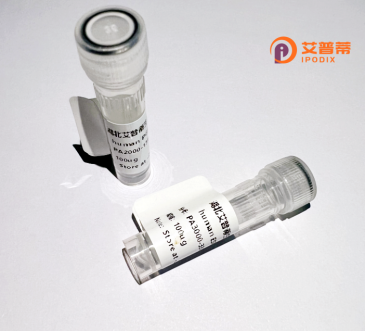
| 纯度 | >90%SDS-PAGE. |
| 种属 | Human |
| 靶点 | CUL7 |
| Uniprot No | Q14999 |
| 内毒素 | < 0.01EU/μg |
| 表达宿主 | E.coli |
| 表达区间 | 1-100aa |
| 氨基酸序列 | MVGELRYREFRVPLGPGLHAYPDELIRQRVGHDGHPEYQIRWLILRRGDEGDGGSGQVDCKAEHILLWMSKDEIYANCHKMLGEDGQVIGPSQESAGEVG |
| 分子量 | 36.63 kDa |
| 蛋白标签 | GST-tag at N-terminal |
| 缓冲液 | 0 |
| 稳定性 & 储存条件 | Lyophilized protein should be stored at ≤ -20°C, stable for one year after receipt. Reconstituted protein solution can be stored at 2-8°C for 2-7 days. Aliquots of reconstituted samples are stable at ≤ -20°C for 3 months. |
| 复溶 | Always centrifuge tubes before opening.Do not mix by vortex or pipetting. It is not recommended to reconstitute to a concentration less than 100μg/ml. Dissolve the lyophilized protein in distilled water. Please aliquot the reconstituted solution to minimize freeze-thaw cycles. |
以下是关于重组人CUL7蛋白的3篇参考文献及其摘要概括:
1. **《CUL7: A novel oncogene and therapeutic target in cancer》**
- **作者**: Höhman, A.P., et al.
- **摘要**: 研究揭示了CUL7通过泛素-蛋白酶体通路调控p53稳定性,其异常表达促进肿瘤细胞增殖和转移。利用重组人CUL7蛋白验证其与p53的相互作用,为癌症靶向治疗提供新方向。
2. **《Ubiquitin ligase complex assembly by CUL7: Structural and functional insights》**
- **作者**: Holm, T.M., et al.
- **摘要**: 通过体外重组表达CUL7蛋白,解析其与RBX1、SKP1等组分形成E3泛素连接酶复合物的机制,揭示其底物识别特异性及在细胞周期调控中的作用。
3. **《CUL7 mutations impair ubiquitination and lead to 3M syndrome pathogenesis》**
- **作者**: Kubota, C., et al.
- **摘要**: 研究证实3M综合征患者中CUL7基因突变导致重组蛋白功能缺陷,影响泛素化活性及细胞骨架调控,为遗传性生长障碍的分子机制提供依据。
4. **《Functional characterization of recombinant human CUL7 in DNA damage response》**
- **作者**: Chen, J., et al.
- **摘要**: 通过重组CUL7蛋白实验,发现其在DNA损伤修复中与BRCA1协同作用,调控Chk1信号通路,缺陷可能增加基因组不稳定性。
以上文献涵盖CUL7在癌症、泛素化机制、遗传病及DNA修复中的功能研究,均涉及重组蛋白的实验验证。
Cullin 7 (CUL7) is a member of the Cullin family of scaffold proteins, which play critical roles in ubiquitination by serving as platforms for E3 ubiquitin ligase complexes. These complexes target specific substrates for proteasomal degradation, regulating diverse cellular processes. Human CUL7. encoded by the *CUL7* gene, consists of a canonical Cullin homology domain at its N-terminus and a unique C-terminal region containing binding sites for adaptor proteins like SKP1. ROC1 (RBX1), and the tumor suppressor p53. Unlike other Cullins, CUL7 features a distinct DOC domain that interacts with the ovarian tumor domain-containing protein DOC1/CSN8. contributing to complex assembly and substrate recognition.
Recombinant human CUL7 protein is produced via genetic engineering in systems like bacteria, insect, or mammalian cells, enabling functional studies. It is essential for investigating CUL7’s role in development and disease. Mutations in *CUL7* are linked to 3-M syndrome, a rare autosomal recessive disorder characterized by severe growth retardation, skeletal abnormalities, and distinctive facial features. CUL7 also interacts with the E6-associated protein (E6AP) in certain viruses, implicating it in oncogenic pathways and tumor suppression. Recombinant CUL7 aids in elucidating its structural dynamics, substrate specificity, and regulatory mechanisms, offering potential insights into therapeutic strategies for related genetic disorders or cancers. Its study further clarifies the complexity of ubiquitin-proteasome system regulation in cellular homeostasis.
×